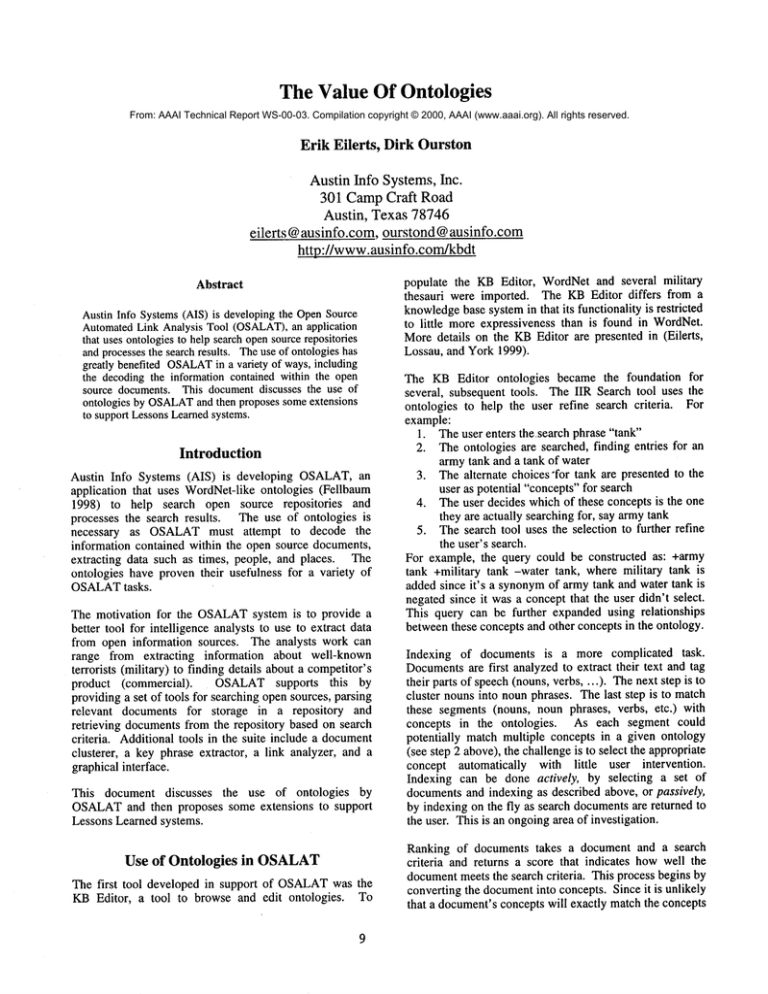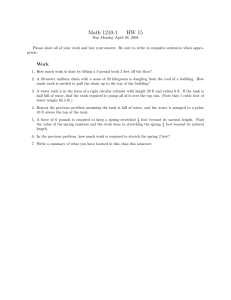
The Value Of Ontologies
From: AAAI Technical Report WS-00-03. Compilation copyright © 2000, AAAI (www.aaai.org). All rights reserved.
Erik Eilerts, Dirk Ourston
Austin Info Systems, Inc.
301 CampCraft Road
Austin, Texas 78746
eilerts @ausinfo.com, ourstond @ausinfo.com
http://www.ausinfo.com/kbdt
Abstract
Austin Info Systems(AIS) is developingthe OpenSource
AutomatedLink Analysis Tool (OSALAT),
an application
that uses ontologiesto help search opensourcerepositories
and processesthe search results. Theuse of ontologieshas
greatly benefited OSALAT
in a variety of ways, including
the decoding the information contained within the open
source documents. This documentdiscusses the use of
ontologies by OSALAT
and then proposes someextensions
to supportLessonsLearnedsystems.
Introduction
Austin Info Systems (AIS) is developing OSALAT,
application that uses WordNet-like ontologies (Fellbaum
1998) to help search open source repositories
and
processes the search results. The use of ontologies is
necessary as OSALATmust attempt to decode the
information contained within the open source documents,
extracting data such as times, people, and places. The
ontologies have proven their usefulness for a variety of
OSALAT
tasks.
The motivation for the OSALAT
system is to provide a
better tool for intelligence analysts to use to extract data
from open information sources. The analysts work can
range from extracting information about well-known
terrorists (military) to finding details about a competitor’s
product (commercial).
OSALATsupports this
providing a set of tools for searching open sources, parsing
relevant documents for storage in a repository and
retrieving documentsfrom the repository based on search
criteria. Additional tools in the suite include a document
clusterer, a key phrase extractor, a link analyzer, and a
graphical interface.
This document discusses the use of ontologies by
OSALAT
and then proposes some extensions to support
Lessons Learned systems.
Use of Ontologies in OSALAT
The first tool developed in support of OSALAT
was the
KBEditor, a tool to browse and edit ontologies. To
populate the KBEditor, WordNetand several military
thesauri were imported. The KBEditor differs from a
knowledgebase systemin that its functionality is restricted
to little more expressiveness than is found in WordNet.
Moredetails on the KBEditor are presented in (Eilerts,
Lossau, and York 1999).
The KB Editor ontologies became the foundation for
several, subsequent tools. The IIR Search tool uses the
For
ontologies to help the user refine search criteria.
example:
1. The user enters the search phrase "tank"
2. The ontologies are searched, finding entries for an
army tank and a tank of water
3. The alternate choices "for tank are presented to the
user as potential "concepts"for search
4. The user decides which of these concepts is the one
they are actually searching for, say armytank
5. The search tool uses the selection to further refine
the user’s search.
For example, the query could be constructed as: +army
tank +military tank -water tank, where military tank is
added since it’s a synonymof army tank and water tank is
negated since it was a concept that the user didn’t select.
This query can be further expanded using relationships
betweenthese concepts and other concepts in the ontology.
Indexing of documents is a more complicated task.
Documentsare first analyzed to extract their text and tag
their parts of speech(nouns, verbs .... ). Thenext step is
cluster nounsinto noun phrases. The last step is to match
these segments (nouns, noun phrases, verbs, etc.) with
concepts in the ontologies. As each segment could
potentially match multiple concepts in a given ontology
(see step 2 above), the challengeis to select the appropriate
concept automatically with little user intervention.
Indexing can be done actively, by selecting a set of
documentsand indexing as described above, or passively,
by indexing on the fly as search documentsare returned to
the user. This is an ongoingarea of investigation.
Ranking of documents takes a document and a search
criteria and returns a score that indicates howwell the
documentmeets the search criteria. This process begins by
converting the documentinto concepts. Since it is unlikely
that a document’sconcepts will exactly matchthe concepts
of the search criteria, relationships betweenconcepts are
explored. For example, in a search for "tank", a document
mayhave a reference to a Panzer, which is a type of army
tank, but no specific mention of the word tank. By
following the parent/child relationship between army tank
and Panzer, the documentwill get a better score because of
this relationship, while a typical keywordsearch mayhave
rejected the documentoutright for not having a specific
reference to "tank". Figure 1 showsa picture of the army
tank concept in the KBEditor and its connection to Panzer.
Discussion
The interesting aspect in the developmentof these tools is
the role that the ontologies play. Everyaspect of the tool is
somehowinfluenced by their use.
Several reasons for this include:
¯ Ontologies define relationships between concepts,
providing much more understanding than simple
keywords
¯ Concepts are defined using a collection of
synonyms, making it easier to identify
relevant terms, evenif they are not exactly
the sameas the input search term.
¯ Ontologies can be specialized into different
subject areas, giving the users a
mechanism to handle domain-specific
issues.
¯ The distance between concepts in an
ontology is a valuable metric of which no
similar value can be computed from
keywords.
tank, armytank, armoredcombatvehicle
[ P:eren|
i military vehic|e
Same
~ ;, armm’edcomba~
vehicle, ACt/I tank
Lessons
.................................
,~......................................................................................................................
~ ’ "I
so, o, iw"’d"
t"
Auth0~$
j
i I Wo~dNet
:1
9Yr~0nYm~~-~i
tanr--~k i a~my
:t~nkI ~trmored
comb~
vehicle/
Figure
1: A Concept
for
Army Tank
The tools described in this section makeup the core of the
OSALAT
application.
OSALAT Example
A typical OSALAT
usage might be:
¯ The user enters a query.
¯
The query tool helps the user to refine their query
into specific concepts
¯ A search tool converts the concepts into search
engine specific query strings and sends the query
to a variety of information sources, such as Alta
Vista, Excite, etc.
¯ The ranking tool is used to score the hits extracted
from the information sources and reject spurious
hits.
¯ The user specifies whichof these final hits are of
most interest. These documents are stored in a
local repository for future retrieval. Theyare in
indexed in the repository using the indexingtool.
10
Learned Extensions
A Lessons Learned (LL) system is one that
captures and stores experiential knowledgefor
later reuse. OSALATcan be extended to
support LLsystems in several ways.
A principal
task would be to extract
information from documentsfor insertion into
Lessons Learned systems. For example,
CALL(the Center for ArmyLessons Learned,
http://call.army.mil)
has over 100,000 lessons learned
documents covering all aspects of the US Army. These
lessons are developed using a bottom-up learning strategy
similar to that described in (van Heijst 1996). All of these
documentsare free text with few attributes encoded. The
development of a LL system to encapsulate all of this
information will be a difficult task to do manually.
OSALAT
could be used as a preprocessor to automatically
extract and codify data from these documents for future
insertion into an ArmyLL system.
Another possible task for OSALAT
is intelligent searching
of LL systems. Since lessons may be stored in free text
documents, retrieving the appropriate lessons requires a
search of both the text and the attributes stored by the LL
system. As a first step, OSALAT
can be used to help
narrowthe focus of the user’s query. It can also be used to
convertqueries into application specific attributes.
Lastly, OSALAT
itself can function as a LL system. The
user can use the search tool to find relevant lessons learned
documents. These documentscan be indexed and stored in
a repository. Later, another search can be performed on
the repository to retrieve the relevant documents.
These tasks provide examples of how OSALAT’suse of
ontologies can be extended to benefit to Lessons Learned
systems.
Conclusions
OSALAT
has centered its functionality around the use of
ontologies. This has proven to be beneficial as the
ontologies drive many of OSALAT’stasks. Ontologies
can also benefit Lessons Learned systems at least in the
areas described by the OSALATLessons Learned
extensions, and likely in manyother areas as well.
Acknowledgements
The work reported on here was supported in part by a
CECOMC2SID Phase II SBIR, contract
number
DAAB07-98-C-D027.
References
B. Chandrasekaran, John R. Josephson, and V. Richard
Benjamins. What Are Ontologies, and WhyDo WeNeed
Them? IEEE Intelligent
Systems, Vol. 14, No. 1,
January/February 1999.
Eilerts, E., Lossau, K., and York, C. 1999. Knowledge
Base Discovery Tool. In Proceedings of the Sixteenth
National Conference on Artificial Intelligence, 904-905.
Boston, Massachusetts: MITPress.
Fellbaum, C. ed. 1998. WordNet: An Electronic Lexical
Database. Cambridge, Mass.: MITPress.
Mayk,et.al. 1998 A KnowledgeBased Doctrine Tool for
Commandand Control. In Proceedings of the Command
and Control Research and Technology Symposium.
Andre Valente, ThomasRuss, Robert MacGregor, and
William Swartout. Building and (Re)Using an Ontology
Air-CampaignPlanning. IEEEIntelligent Systems, Vol.
14, No. 1, January/February1999.
van Heijst, G., van der Spek, R., & Kruizinga, E. (1996).
Organizing Corporate Memories. In Proceedings of the
10th Banff Workshop on Knowledge Acquisition for
Knowledge-Based Systems, 1996. Available online:
http://ksi.cpsc.ucalgary.ca/KAW/KAW96/KAW96Proc.ht
ml
11








